Are you dreaming of harvesting exotic fruits from your own backyard? Our unique climate makes it the perfect place to grow a variety of tropical fruits for Florida. And you won’t need professional expertise! As the only continental U.S. state where many tropical fruits thrive year-round, Florida offers homeowners an incredible opportunity to cultivate their own slice of paradise.
Why Florida Is Perfect for Growing Tropical Fruits
Florida’s warm, humid climate creates ideal conditions for tropical fruit cultivation that most Americans can only dream about. With growing zones ranging from 9 in the northern regions to 11 in the Keys, different areas of the state support various tropical species.
Most tropical fruits require minimum temperatures that stay above 32°F, which is why central and southern Florida regions have traditionally been the sweet spots for exotic fruit production. However, climate change is gradually expanding growing possibilities into more northern areas of the state, opening new opportunities for gardeners throughout Florida.
Likewise, climate change has ag researchers burning the midnight oil, developing more cold-hardy varieties that will take the occasional North Florida frost. They’ve also been working diligently to provide a solution to citrus greening, a disease that has wiped out the majority of Florida’s traditional citrus industry.
Growing your own tropical fruits provides significant economic benefits. You’ll save money on store-bought fruits while ensuring you’re getting the freshest, most nutritious produce possible. It’s also environmentally friendly. Growing your own food reduces the carbon footprint associated with commercially shipped fruits.
Papaya: The Ultimate Beginner’s Tropical Fruit
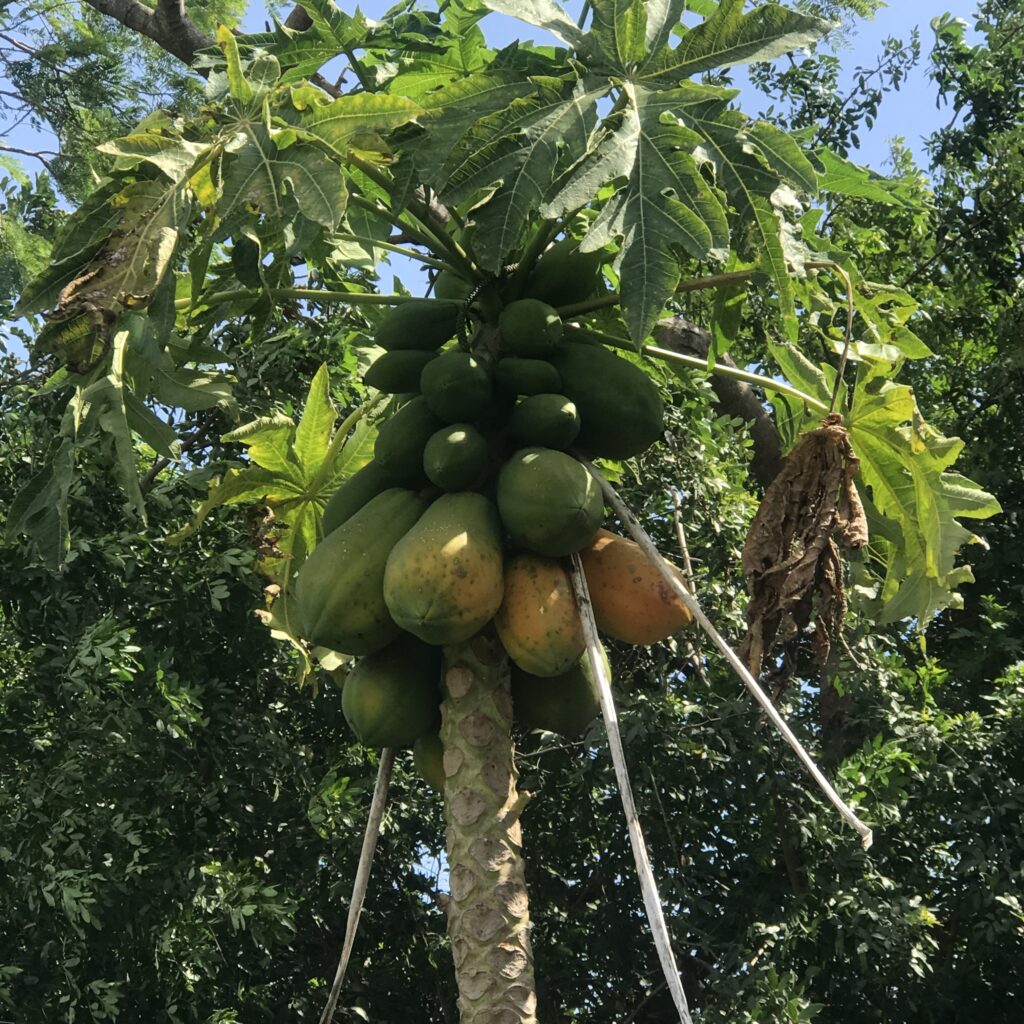
If you’re new to tropical fruit growing, papayas should top your list! These fast-growing plants can produce fruit within 10-12 months of planting, making them perfect for impatient gardeners.
Papayas aren’t technically trees but large herbaceous plants with hollow stems that can reach 10-15 feet tall while maintaining a relatively small footprint in your landscape.
To grow papayas successfully in Florida:
- Choose a sunny, well-drained location protected from strong winds
- Plant in slightly elevated beds if your soil tends to retain water
- Use rich, organic soil amended with compost
- Water regularly but don’t overwater—papayas hate “wet feet”
For Florida gardens, varieties like ‘Red Lady’, ‘Maradol’, and ‘Solo’ perform exceptionally well. ‘Red Lady’ is particularly recommended for beginners due to its disease resistance and reliable production of sweet, reddish-orange flesh fruits.
Papaya plants are either male, female, or hermaphrodite. For consistent fruit production, plant several to ensure proper pollination, or specifically seek out self-pollinating hermaphrodite plants.
Once established, a healthy papaya plant can yield 30-50 fruits annually, providing a continuous harvest throughout the year in South Florida.
Bananas: Beyond the Grocery Store Varieties
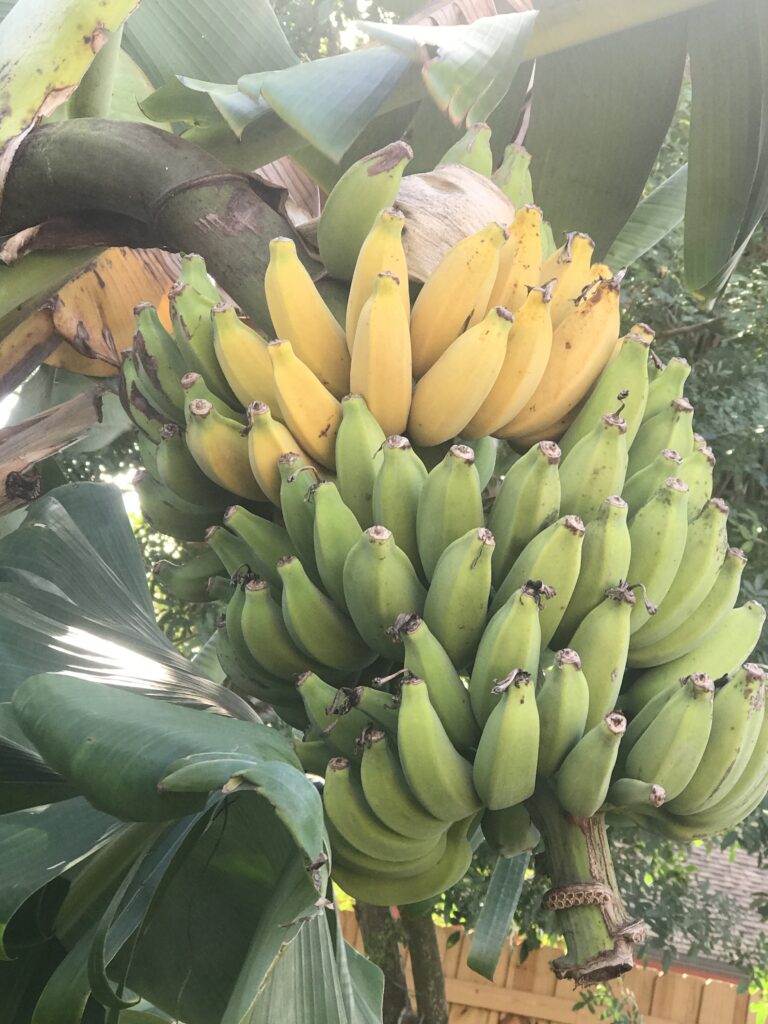
Bananas might be the most beginner-friendly tropical fruit for Florida gardeners! Unlike bananas from grocery stores, home gardeners can explore diverse varieties with unique flavors and cold tolerance.
For Florida conditions, consider these banana varieties:
- ‘Lady Finger’ (or ‘Sugar Banana’) – Sweeter than commercial varieties with better cold tolerance
- ‘Ice Cream’ (or ‘Blue Java’) – Creamy, vanilla-flavored fruit with good cold hardiness
- ‘Orinoco’ (or ‘Burro’) – Extremely cold-hardy cooking banana, perfect for North Florida
- ‘Goldfinger’ – Disease-resistant with apple-like flavor notes
And to be fair, those Cavendish varieties you find at the grocery store are nothing to sneer at. I’ve been growing Dwarf Cavendish for over 20 years, and they’ve proven to be the most reliable performers in my Florida landscape.
Grow in a Banana Circle
Consider creating a “Banana Circle” to help bananas grow fast with a minimum of care and input.
A banana circle is a tropical permaculture technique ideal for Florida’s warm, rainy climate. It’s a circular planting pit used to grow bananas and other tropical plants together while recycling organic waste. The design captures water, builds fertile soil, and supports lush growth with minimal input.
A banana circle is a smart addition to any Florida yard because it turns yard waste into rich soil while making the most of Florida’s heavy rains. The design naturally captures water in a central pit, preventing runoff and keeping the surrounding plants well-hydrated.
As you fill the pit with kitchen scraps, leaves, and other organic matter, it breaks down into nutrient-rich compost that feeds your bananas and companion plants. Over time, this not only improves soil fertility but also creates a lush, productive microclimate. You can also use the circle to grow other tropical crops like papayas, taro, and sweet potatoes — all while reducing the amount of yard waste you throw away and the money spent on water and fertilizer.
How to prepare a banana circle:
Dig a 5–6 ft wide, 2–3 ft deep circular pit.
Use the excavated soil to build a raised ring mound around the edge.
Fill the pit with layers of compost, leaves, kitchen scraps, and yard debris.
Plant banana pups around the outer ring.
Mulch heavily and water deeply to get it started.
Add more organic matter throughout the year as available (I add lawn clippings, weeds).
Year-Round Bananas
Even after occasional cold damage to the foliage, banana plants typically recover quickly once temperatures warm up. In South and Central Florida, you can expect fruit within 10-15 months after planting.
For North Florida gardeners, consider growing bananas in an area out of the wind. Occasional freezes happen, but it’s cold winds that do the the most damage.
Check out our detailed guide for growing bananas in Florida here.
Mango: Florida’s Beloved Backyard Fruit
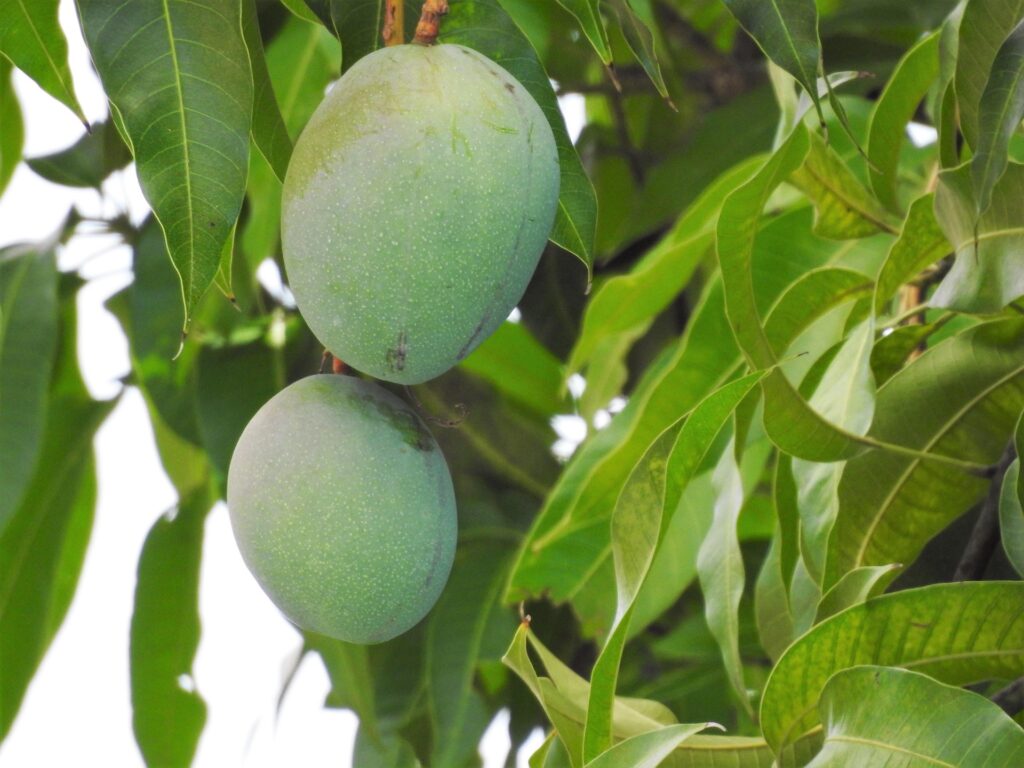
No Florida tropical fruit garden is complete without a mango tree! While standard mango trees can grow quite large, dwarf varieties make this beloved fruit accessible even for smaller yards or container growing.
When planting mangoes:
- Choose the sunniest location available (minimum 6 hours of direct sun)
- Ensure excellent drainage — raised beds are ideal in many Florida areas
- Plant in an area protected from strong winds
- Allow adequate space for mature size (8-15 feet for dwarf varieties)
The key to mango success in Florida is managing anthracnose, a fungal disease exacerbated by our humid conditions. Preventative measures include planting resistant varieties, ensuring good air circulation through proper spacing and pruning.
Avoid overhead irrigation, particularly after sundown. You can also apply appropriate fungicides during flowering and early fruit development. I like using organic copper sulfate to treat fungal diseases.
With proper care, even dwarf mango trees can produce 20-30 fruits annually once established, typically beginning their third or fourth year after planting.
Avocado: Cold-Hardy Varieties for Florida Success
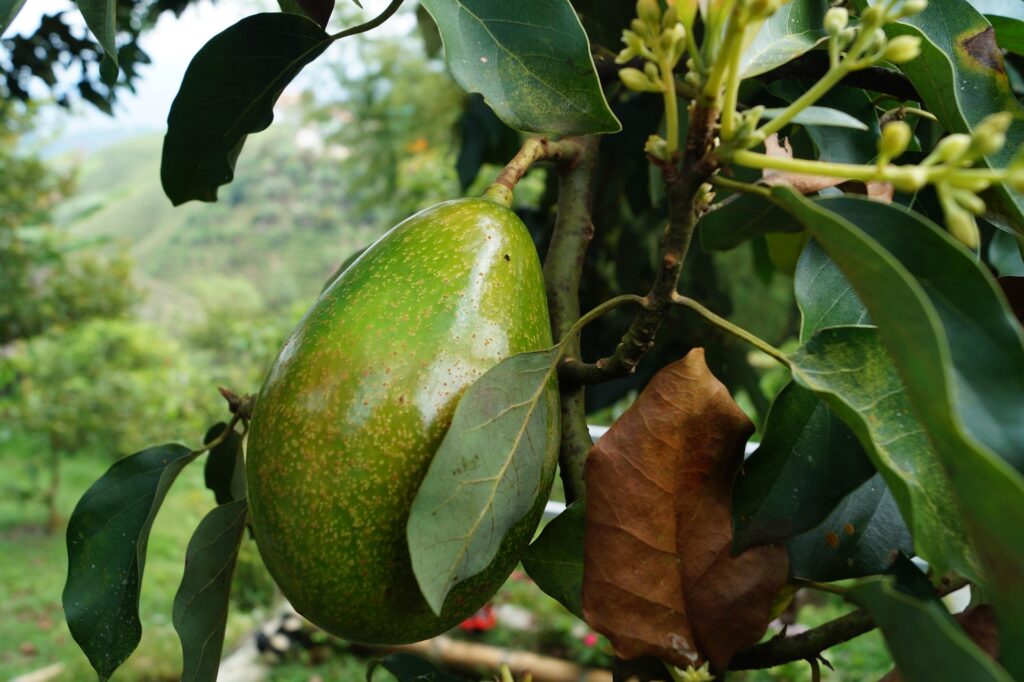
While California’s Hass avocados get most of the attention, Florida’s climate actually favors different varieties that perform better in our humidity and occasional rainfall extremes.
For Florida gardens, consider these avocado varieties:
- ‘Lula’ – Cold-hardy to 30°F, excellent for North Florida
- ‘Choquette’ – Survives brief dips to 25°F and is disease resistant
- ‘Brogdon’ – Cold-hardy with purple-black skin and excellent flavor
Florida’s occasionally waterlogged soils can cause root rot in avocados, so proper planting is critical.
Select a site on higher ground with excellent drainage and plant on a slight mound. Mulch well, but keep mulch away from the trunk. Never over-water — avocados prefer to dry slightly between waterings
Unlike some fruit trees, most avocado varieties are self-pollinating, though having multiple varieties can improve yields. For avocado success, understand that fruits don’t ripen on the tree—harvest when full-sized and allow to soften indoors for 3-7 days.
Pineapple: The Perfect Container Tropical Fruit
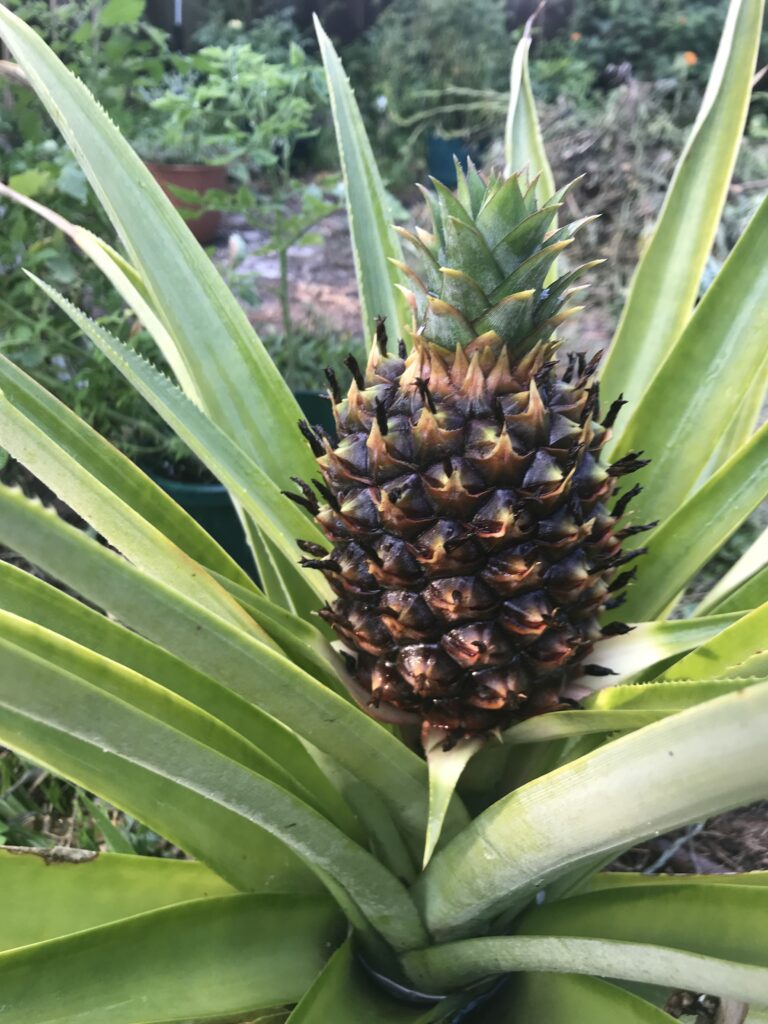
Pineapples might be the easiest tropical fruit to grow in Florida, requiring minimal space and care! The best part? You can start with the top of a store-bought pineapple.
To grow pineapples from grocery store tops:
- Cut the crown (leafy top) leaving about half an inch of fruit attached
- Remove some of the lower leaves, exposing about an inch of stem
- Let it dry for 5-7 days to callus over
- Plant in well-draining soil mix (equal parts garden soil, sand, and compost works well)
Pineapples thrive in containers at least 5 gallons in size, making them perfect for patios and balconies. They require full sun (minimum 6 hours) and well-draining soil. That last part is crucial — as water-logged pineapple plants get root rot quite easily. Allow the plants to dry between waterings and fertilize lightly every 2-3 months.
While commercial production uses growth regulators to force flowering, home gardeners can trigger flowering by placing a ripe apple near the center of the plant and covering both with a plastic bag for 3-5 days. The ethylene gas released by the apple initiates flowering.
From planting to harvest typically takes 18-24 months in Florida, with each plant producing one fruit. However, the original plant will produce offshoots (called “pups”) that can be separated and grown for future harvests.
Many Florida gardeners go to heroic efforts to protect their ripening pineapple fruits. They begin to smell absolutely delicious to any and every fruit-loving critter. I use a very sturdy tomato cage around mine, and then wrap the whole thing in hardware cloth.
Other Easy-to-Grow Tropical Fruits for Florida Gardens
While the previous are some of the more popular tropical fruits for Florida, here are a few outliers you might want to try.
Star Fruit (Carambola)
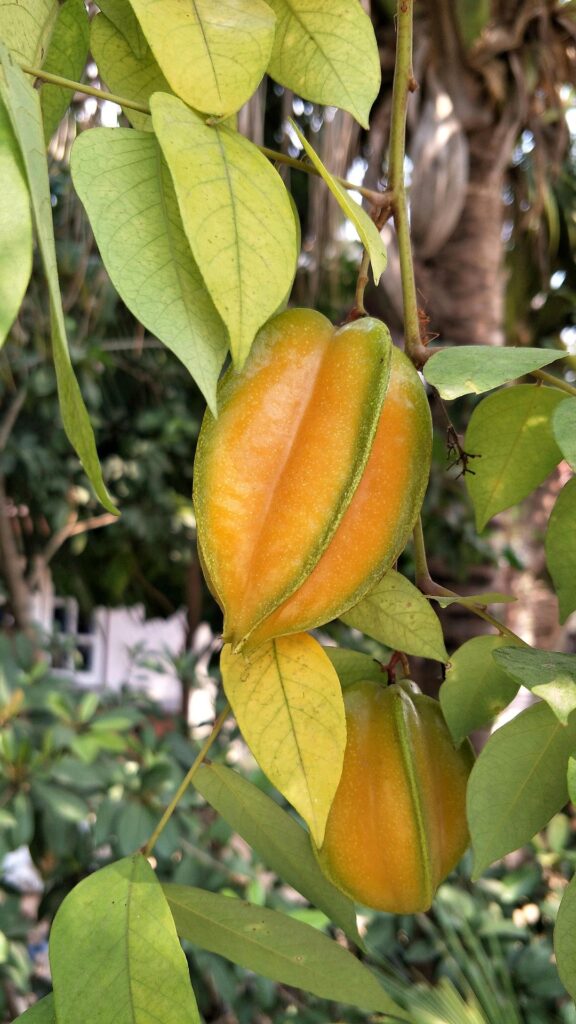
Star fruit trees are remarkably adaptable to Florida conditions and produce distinctive five-ridged fruits with a sweet-tart flavor. Varieties like ‘Arkin’ and ‘Kary’ perform exceptionally well in Florida landscapes.
These attractive trees reach 15-25 feet tall and can bear fruit within 2-3 years of planting.
Lychee
While requiring some patience (typically 3-5 years before fruiting), lychees reward Florida gardeners with delicious aromatic fruits. ‘Brewster’ and ‘Mauritius’ varieties perform well across much of the state.
Lychees prefer slightly acidic soil and protection from afternoon sun in the hottest regions.
Passion Fruit
For those with limited space, passion fruit vines offer an excellent option, growing on trellises, fences, or pergolas. The purple variety (Passiflora edulis) thrives in South and Central Florida, producing aromatic fruits within the first year.
These vigorous vines can grow 15-20 feet annually, requiring strong support structures. However, be warned that squirrels like them even more than people do.
Guava
Adaptable and productive, guava trees produce fragrant fruits with exceptional nutritional value. Varieties like ‘Ruby Supreme’ and ‘Thai White’ perform exceptionally well in Florida. These small trees (8-15 feet) can be maintained even smaller through pruning, making them suitable for modest gardens.
Guavas are remarkably pest-resistant and can begin producing fruit within 1-2 years, offering multiple harvests annually in ideal conditions.
Jackfruit
For those with larger properties, jackfruit trees offer remarkable productivity, with a single tree potentially producing hundreds of pounds of fruit. This fast-growing tree can reach 30-40 feet, but can be maintained smaller with regular pruning.
Jackfruit’s versatility — used both as a fruit when ripe and as a meat substitute for vegan diets when unripe — makes it increasingly popular in Florida gardens. It does require a lot of space and may be considered an “acquired taste.’
Barbados Cherry (Acerola)
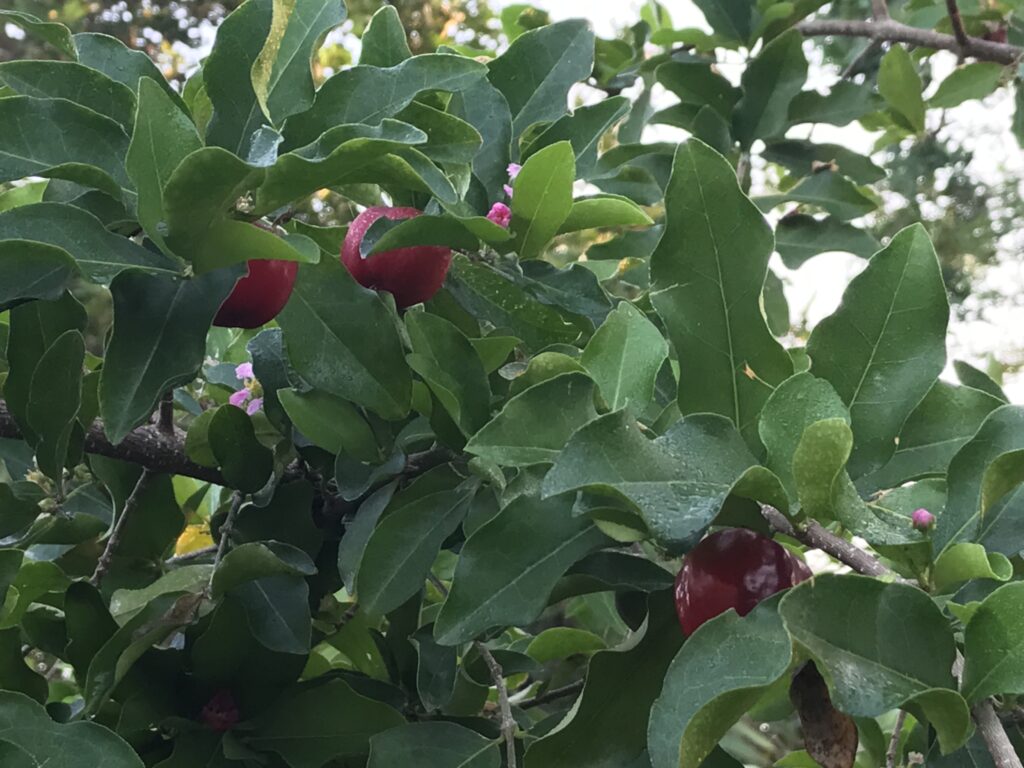
Barbados cherry is a perfect addition to Florida gardens, prized for its incredibly high vitamin C content — up to 40 times that of oranges! This small tree or large shrub (10-15 feet) adapts well to Florida’s climate, producing small, bright red cherries multiple times per year.
The challenge with Acerola cherry is finding ways to work it into the menu. It’s very tangy and best eaten fresh when almost overripe — straight from the tree. However, I have had some success using it as a fermented fruit drink.
Varieties like ‘Florida Sweet’ perform exceptionally well in Central and South Florida, offering better sweetness than wild types. Barbados cherries prefer full sun but tolerate partial shade and begin producing within 2-3 years of planting.
Loquat
Loquat (Japanese plum) is one of the more cold-hardy tropical fruits, thriving throughout most of Florida, including northern regions. This attractive evergreen tree produces sweet-tart yellow-orange fruits in late winter to early spring when few other fruits are harvesting.
Reaching 15-20 feet tall with minimal maintenance, loquats are remarkably resistant to pests and diseases common in Florida. Varieties like ‘Champagne’ and ‘Vista White’ offer superior flavor and perform exceptionally well in Florida landscapes.
Finger Limes
Finger limes, sometimes called “citrus caviar,” are increasingly popular in Florida gardens for their unique pearl-like pulp vesicles that pop with tangy flavor. These slow-growing, somewhat thorny bushes (6-10 feet) produce slender, finger-shaped fruits and are more cold-tolerant than many tropical fruits, suitable for protected areas even in North Florida.
Finger limes prefer well-drained soil, partial shade in the hottest regions, and are relatively drought-tolerant once established, making them excellent for water-conscious Florida gardeners.
Jaboticaba
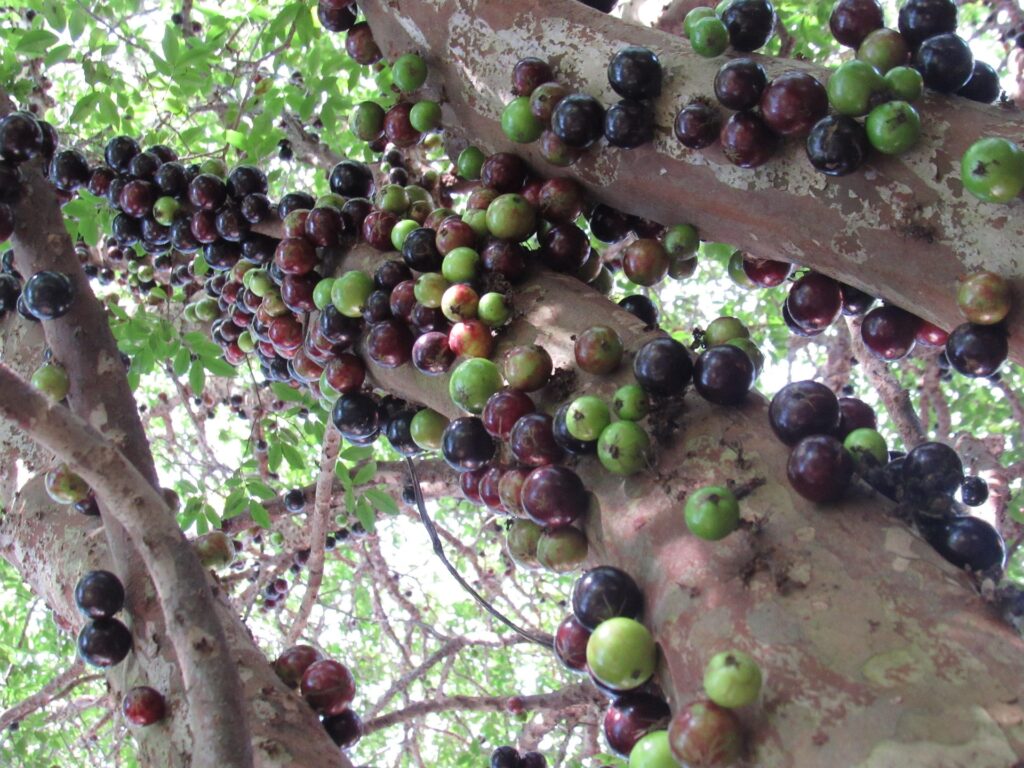
Jaboticaba offers one of the most unusual fruiting habits of any tropical — grape-like fruits grow directly on the trunk and main branches rather than on twigs! This slow-growing Brazilian native reaches 10-15 feet in Florida landscapes and can live for 100+ years, becoming increasingly productive with age.
While requiring patience (often 8+ years before significant fruiting), established trees can produce 4-5 crops annually in South Florida. The dark purple fruits with white pulp offer a unique sweet-tart flavor resembling grapes with floral notes.
Mamey Sapote
Mamey sapote rewards patient Florida gardeners with large fruits featuring sweet, creamy salmon-colored flesh often described as tasting like a combination of sweet potato, pumpkin, and almond. While these trees can grow quite large (30-40 feet), dwarf varieties like ‘Pantin’ and ‘Key West’ are more manageable for home gardens.
Mamey sapotes are remarkably adaptable to Florida’s various soil types, relatively drought-tolerant once established, and begin bearing fruit within 3-5 years when grown from grafted trees.
Longan
Often called “dragon eye” for its translucent white flesh surrounding a dark seed, longan is closely related to lychee but generally more adaptable to Florida’s growing conditions. These productive trees (20-30 feet) perform particularly well in Central and South Florida, with varieties like ‘Kohala’ and ‘Biew Kiew’ offering reliable production and excellent flavor.
Longans typically begin bearing within 3-5 years of planting, producing clusters of sweet, aromatic fruits that ripen during summer months and have excellent shelf life compared to many tropical fruits.
Dragon Fruit (Pitaya)
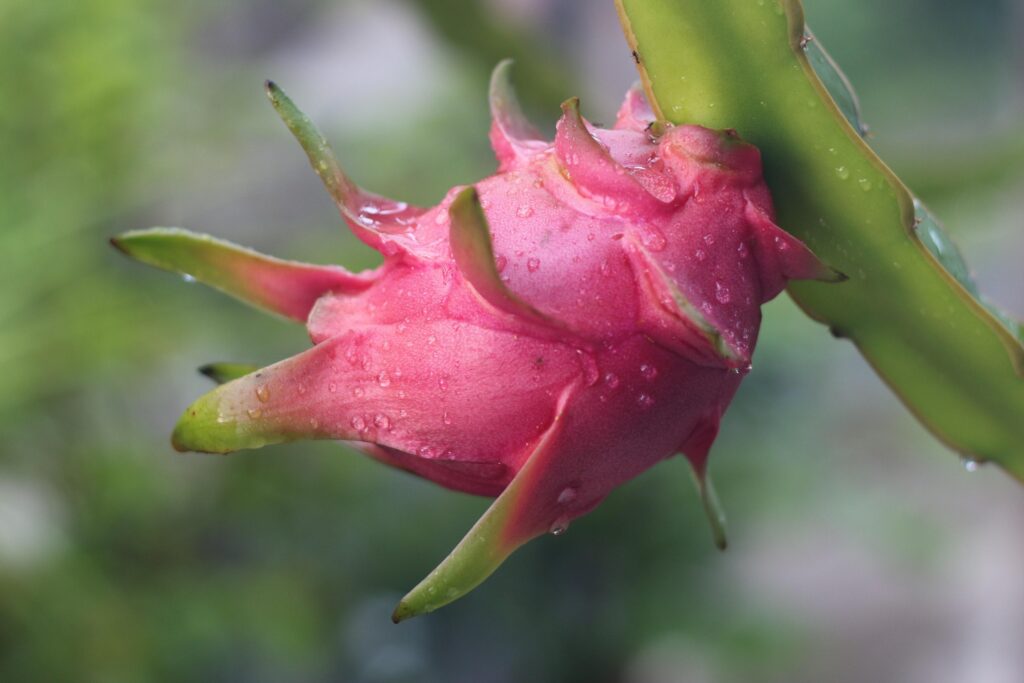
Dragon fruit is perhaps the most visually striking tropical fruit you can grow in Florida, with its vibrant pink or yellow skin and white or red flesh speckled with tiny black seeds. These climbing cacti are perfect for small spaces, growing vertically on trellises, walls, or posts with minimal horizontal footprint.
Surprisingly fast to produce, dragon fruit can begin bearing within 6-12 months of planting and thrive throughout most of Florida. Varieties with red flesh, like ‘Physical Graffiti’ and ‘Natural Mystic,’ offer superior sweetness compared to the more common white-fleshed types and perform exceptionally well in Florida’s climate.
Common Challenges and Solutions for Tropical Fruit for Florida Gardeners
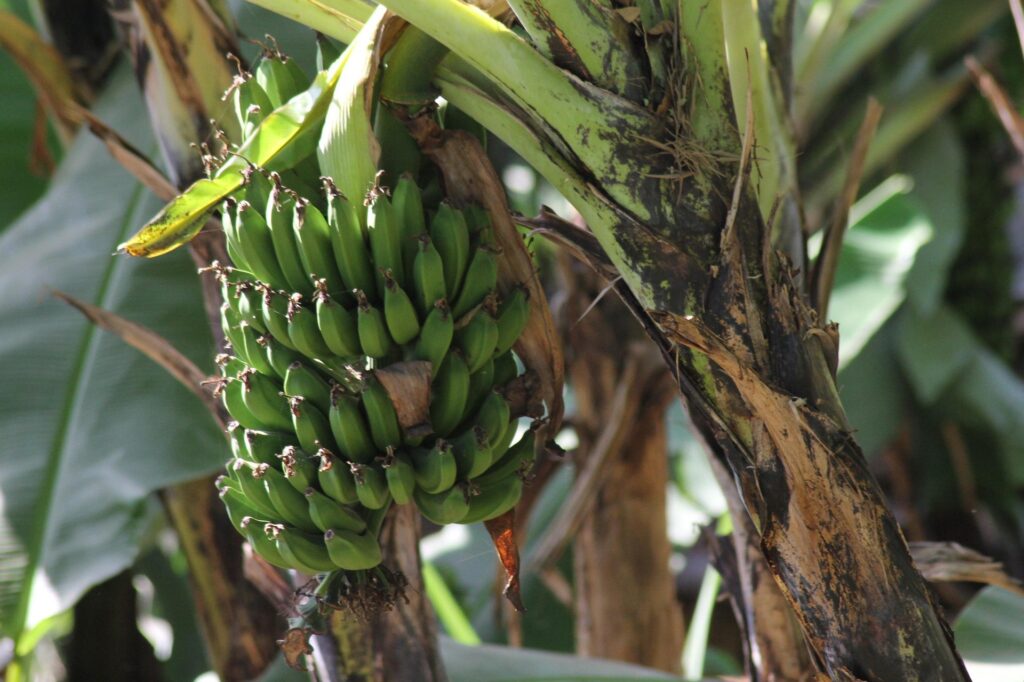
Very few regions can claim to be a gardening paradise, and Florida is no exception. The key to success in any climate means staying aware of obstacles specific to your environment.
Pest Management
Florida’s year-round growing season means year-round pest pressure. Key strategies include:
- Introducing beneficial insects like ladybugs and lacewings
- Using lightweight horticultural oils for scale and mealybugs
- Applying neem oil as an organic multi-purpose treatment
- Installing fruit bags over developing fruits to protect from fruit flies
- Regular inspection of plants, especially the undersides of leaves
Disease Prevention
High humidity creates perfect conditions for fungal diseases. Preventative measures include:
- Proper spacing for air circulation
- Morning irrigation to allow foliage to dry during the day
- Removing dead or diseased plant material promptly
- Using copper-based fungicides preventatively during rainy seasons
- Selecting disease-resistant varieties when possible
Freeze Protection
Even in Florida, occasional cold snaps pose risks to tropical fruits. Preparation is key:
- Keep young trees well-watered before expected freezes
- Use anti-transpirant sprays to reduce moisture loss during cold periods
- Cover smaller plants with frost cloth (not plastic) before sunset
- Install Christmas lights (traditional, not LED) under covers for additional warmth
- Bank soil around the bases of young trees for trunk protection
Drainage Solutions
Florida’s heavy summer rains can challenge tropical fruit trees. Improve drainage by:
- Planting on mounds or raised beds
- Incorporating organic matter and sand into heavy soils
- Installing French drains in problem areas
- Using container growing in areas with high water tables
- Applying mulch to regulate soil moisture (keeping it away from trunks)
Hurricane Preparation
Living in Florida means preparing your garden for potential hurricanes:
- Maintain trees with regular pruning to avoid top-heaviness
- Install strong support systems for younger trees
- Remove coconuts, large fruits, and dead fronds before storm season
- Consider planting wind-resistant varieties
- Have materials ready to brace valuable specimens during storm warnings
Get Ready to Create Your Tropical Paradise
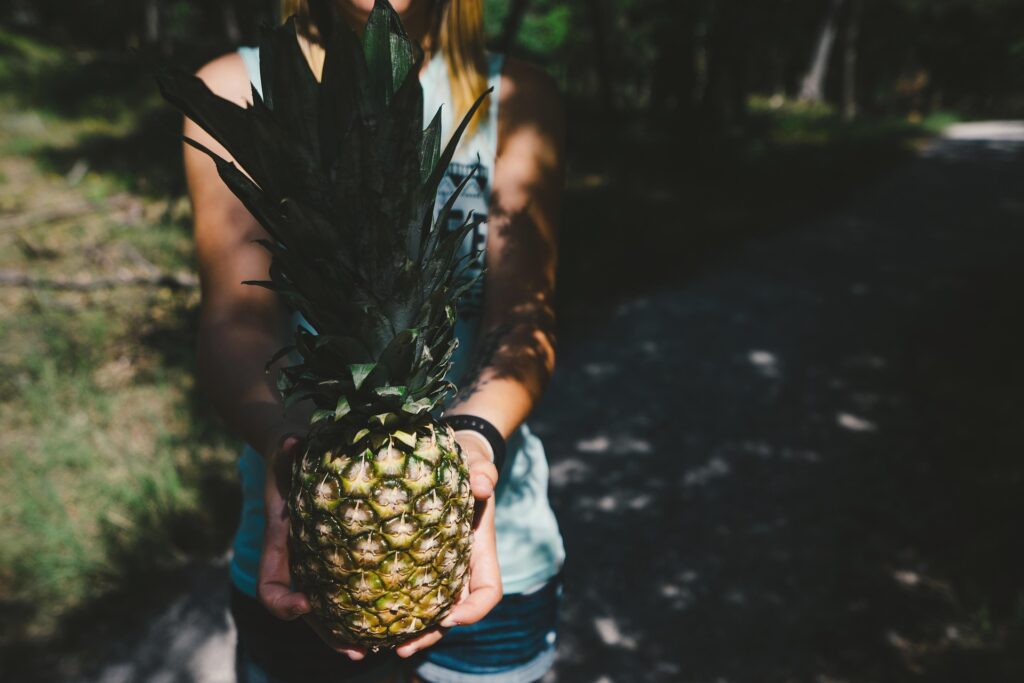
Growing tropical fruits in Florida offers a rewarding experience that connects you with the state’s unique agricultural heritage while providing nutritious, homegrown produce. By starting with beginner-friendly options like papayas, bananas, and pineapples, you’ll gain confidence while enjoying exotic fruits that grocery stores simply can’t match for freshness and flavor.
Remember that proper site selection, adequate drainage, and occasional protection from extreme weather are key to success in our unique climate. As your experience grows, you can expand your tropical fruit garden to include more varieties, creating your own personal paradise of delicious, nutritious fruits right in your Florida backyard.
Ready to get started? Pick one or two fruits from our guide, prepare your space, and begin your tropical fruit growing adventure today!